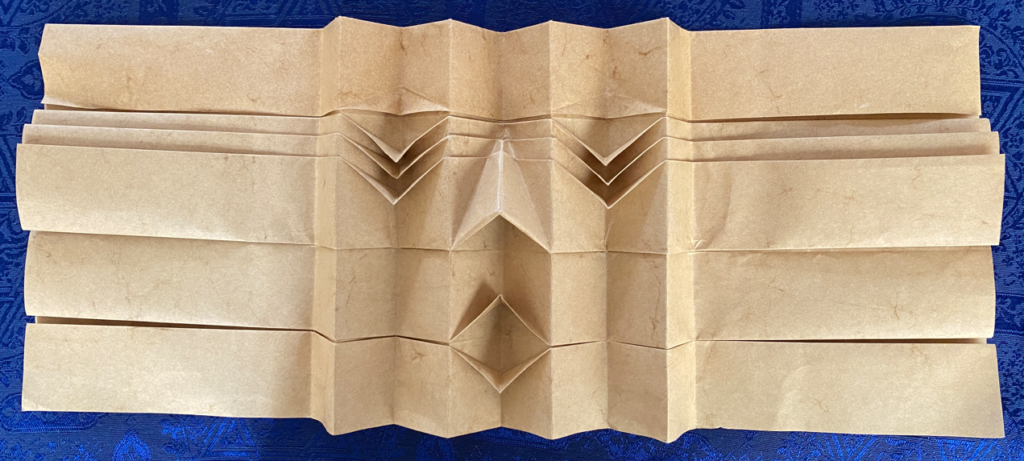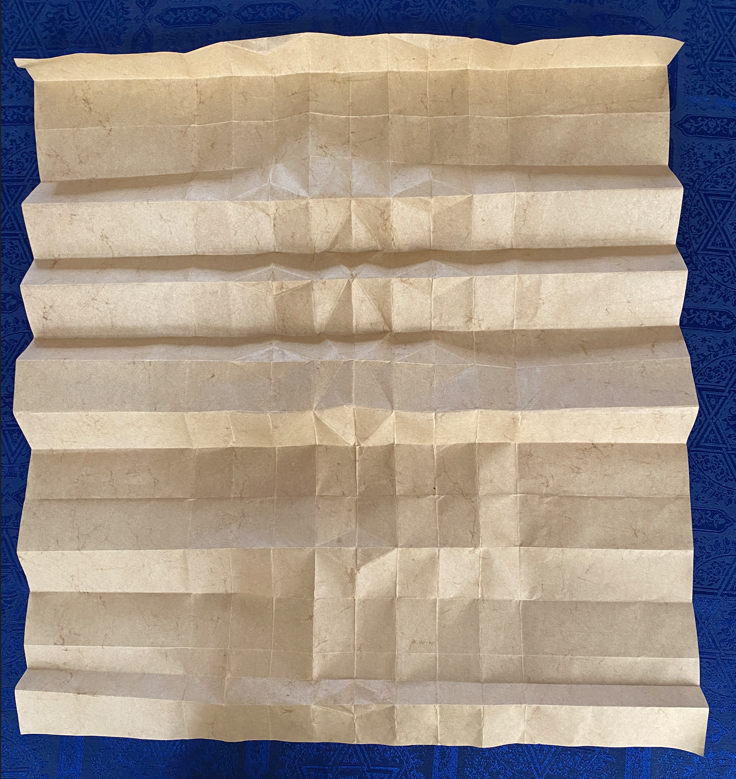By Joel Stern, December 9, 2023
I’d like to dedicate this D’var Torah to the memory of David Ellenson, zichrono livracha, who passed away this week. David and his family were longtime members of this Minyan, and he was not only a wonderful friend to my family and to many others here, but a brilliant scholar of Judaism. He accomplished many things in his career, and he had a heart of gold. He will be deeply missed.
This week we began the story of Joseph. Joseph is one of the most fully developed characters in the Bible, and has always fascinated me. I practice origami, the art of paperfolding.

One of the interesting aspects of origami is the fact that once you fold a model, the creases remain forever. And when you unfold the model, you can see the crease pattern.


In fact, some people who study origami crease patterns can figure out the model it folds into.
When I thought about origami crease patterns and their resulting shape, I saw a connection to the Joseph story. When Joseph says to his brothers, “It was to save life that God sent me ahead of you,” he is identifying a pattern, or blueprint, for his life, albeit one defined by God.
But life patterns aren’t just shaped by events, they’re also shaped by the traits given to us at birth. The crease pattern I showed you represented all of the traits Joseph was born with — his sizable ego, his deep intelligence, his insight into dreams. Throughout his life, Joseph suffered greatly, losing — and gaining — over and over again. And each event contributed to the man he was by the time he revealed himself to his brothers — a man whose face reflected not only his innate qualities, but each and every harrowing and triumphant event of his life.
Question – Do patterns imply predetermination? Is there a connection between them? If we find ourselves following a pattern, isn’t that admitting that we’re not in control? And if we’re not in control, then we go where our patterns of behavior force us to go. And if so, isn’t that predetermination?
In 1965, Paul Simon declared in his song “Patterns”:
From the moment of my birth
To the instant of my death
There are patterns I must follow
Just as I must breathe each breath
Like the color of my skin
Or the day that I grow old
My life is made of patterns
That can scarcely be controlled
Despite his fatalistic point of view in this song, Paul Simon’s later career certainly doesn’t exemplify someone who is stuck in repeating patterns.
Patterns… and predetermination…
Over the centuries, some rabbis interpreted events in the Bible as a blueprint for the Jewish people. The Ramban states in his commentary to Genesis 12:6:
I will tell you a principle by which you will understand all the coming portions of Scripture concerning our forefathers. Ma’ase la’avot siman l’banim… “Whatever has happened to the patriarchs is a sign to the children.”
In other words, Jewish history is cyclical. What happened to our ancestors is repeated over and over again, in different ways, with succeeding generations of the Jewish people. I’m sure that we can all think of examples of this dynamic, especially, and tragically, from the past few months. So… one part of our tradition certainly does see a connection between patterns and predetermination.
Yet, another part of our tradition disagrees, at least in part, with this notion. As Rabbi Akiba says in Pirke Avot 3:15: Hakol tsafui, v’har’shut n’tunah. “All is foreseen, yet freedom is granted.”
This debate continues today. A book that has received considerable publicity, just in the last few months, is Determined: A Science of Life Without Free Will, written by Robert Sapolsky, a neuroendocrinology researcher. Sapolsky argues that there is no free will, or at least that there is much less free will than generally assumed. He claims that human actions are determined by neurobiology, hormones, childhood, and life circumstances. He therefore excuses “criminal” acts by positing that an individual could not have done anything differently at any given moment in time, due to genetics and life events.
This is an extremely dangerous point of view. If we look at events through the lens of “this is the only possible outcome,” then individuals are absolved of any responsibility, or accountability, for their actions.
Yet, sometimes it does seem that our lives are on an immutable path, and that we are stuck in unproductive or destructive patterns from which we can’t break free. Nevertheless, we must realize that nothing is inevitable. We must reject the view that our lives are predetermined. We can change our patterns of behavior.
Sometimes it takes a crisis to disrupt a behavior pattern. Remember Joseph? Throughout the story he displays a stony presence, until finally, no longer able to maintain his façade, he breaks down in tears, and embraces his estranged brothers.
Today, we pray that the terrible crisis for our people in Israel and around the world, and for all those suffering, will result in changing patterns of behavior — at a profound, seismic level — when hatred and prejudice will transform into acceptance and tolerance. This is the Chanukah miracle that we so desperately need today.
Bayamim hahem baz’man hazeh.
May the miracles that occurred in days of old occur again in our day.
Shabbat Shalom!
